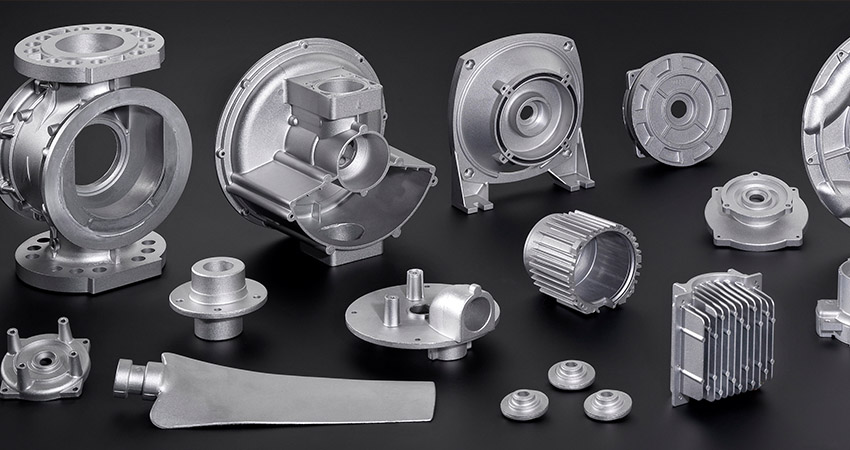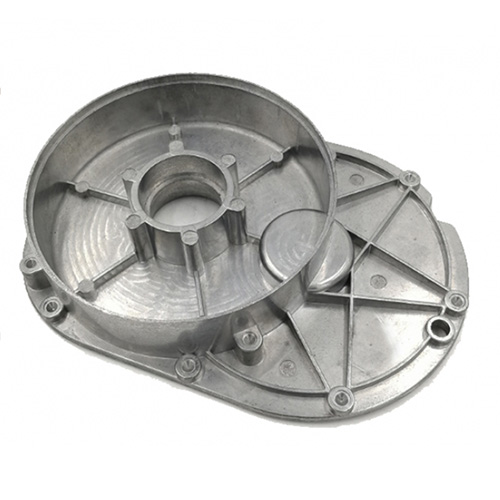Everything You Need to Learn About the Uses and Perks of Aluminum Castings
Aluminum castings play a vital role across various industries, offering distinct properties that improve item performance. Their lightweight nature and stamina make them optimal for applications in automobile and aerospace industries. Additionally, the adaptability of casting approaches permits complex designs and tight resistances. As the demand for sustainable solutions rises, recognizing the advantages and applications of aluminum castings comes to be increasingly vital. What certain advantages do they offer over various other products?
Overview of Aluminum Casting Processes
Aluminum casting procedures include a selection of strategies utilized to shape liquified aluminum right into wanted types. These approaches include sand spreading, die spreading, and investment casting, each offering unique advantages relying on the application (Aluminum Casting). Sand casting entails producing a mold and mildew from sand, permitting intricate styles and large components, while die spreading uses high stress to inject molten aluminum right into metal mold and mildews, guaranteeing accuracy and smooth surfaces. Investment casting, likewise referred to as lost-wax spreading, creates complicated shapes with excellent dimensional precision, making it appropriate for comprehensive components
These procedures are characterized by their capability to create lightweight, durable components that show exceptional corrosion resistance. The adaptability of aluminum permits personalization in numerous industries, from vehicle to aerospace. In addition, the capability to reuse aluminum boosts the sustainability of these casting processes, decreasing ecological impact while preserving material stability. Recognizing these strategies is necessary for maximizing manufacturing efficiency and achieving high-grade aluminum castings.
Key Applications of Aluminum Castings
Aluminum castings play a necessary duty throughout numerous industries, particularly in automobile, aerospace, and consumer electronics. In the vehicle market, they add to light-weight frameworks that improve gas performance. In a similar way, aerospace parts profit from aluminum's strength-to-weight proportion, while consumer electronic devices utilize its convenience for reliable manufacturing.
Automotive Market Applications
As the vehicle industry remains to evolve, manufacturers increasingly depend on aluminum castings for their light-weight yet long lasting residential or commercial properties. These castings play an important role in boosting automobile performance, fuel efficiency, and total safety and security. Secret applications include engine blocks, transmission real estates, and architectural components, which profit from aluminum's excellent strength-to-weight proportion. Furthermore, aluminum castings facilitate intricate geometries, permitting for cutting-edge designs that improve the rules of aerodynamics and reduce drag. The rust resistance of aluminum additionally contributes to durability, minimizing maintenance prices for both makers and consumers. As electric vehicles gain appeal, aluminum castings are vital for battery enclosures and various other parts, even more strengthening their significance in the future of auto production.
Aerospace Element Production
In the aerospace industry, aluminum castings are indispensable to the production of light-weight, high-performance elements. These castings are crucial for producing components such as engine housings, architectural structures, and landing equipment parts, where weight decrease is vital for gas performance and overall efficiency. The outstanding strength-to-weight proportion of aluminum permits the advancement of complicated geometries that boost the rules of aerodynamics. Furthermore, aluminum's resistance to deterioration adds to the long life and dependability of aerospace components, ensuring safety in flight procedures. The casting process likewise permits for specific tolerances, which is essential in conference stringent aerospace sector requirements. In general, aluminum castings play an essential duty beforehand aerospace modern technology while supporting the industry's promote sustainable techniques.
Consumer Electronics Production
The use of aluminum castings in customer electronics manufacturing has actually come to be significantly substantial as a result of their lightweight and durable buildings. Manufacturers utilize these castings to create components for various tools, consisting of smart devices, laptop computers, and pc gaming consoles. Aluminum's superb thermal conductivity additionally assists in warm dissipation, improving gadget performance and longevity. Additionally, the versatility of aluminum permits elaborate styles and complicated geometries, allowing sleek and modern-day visual appeals that attract consumers. In addition, aluminum castings can be quickly recycled, straightening with the expanding demand for sustainable manufacturing methods. As technology advancements, the duty of aluminum castings in establishing innovative and effective customer electronics is anticipated to increase, making them a staple in the industry.

Benefits of Making Use Of Aluminum Castings
While different products are offered for casting, aluminum sticks out due to its one-of-a-kind mix of light-weight homes, toughness, and corrosion resistance. The reduced thickness of aluminum makes it an ideal option for applications where weight decrease is crucial, such as in the auto and aerospace sectors. Its excellent strength-to-weight ratio permits manufacturers to produce durable elements without including too much weight.
Additionally, aluminum castings can be produced with elaborate layouts and tight tolerances, allowing complicated geometries that are difficult to achieve with other products. The versatility of aluminum enables for numerous casting approaches, including discover this sand, die, and investment spreading, satisfying varied production needs. Aluminum's ease of machining and completing enhances its appeal, helping with the production of high-grade surface area coatings. On the whole, the advantages of utilizing aluminum castings contribute to enhanced performance and effectiveness in numerous applications throughout various industries.
Corrosion Resistance in Aluminum Castings

Natural Oxide Layer
An all-natural oxide layer kinds on the surface area of aluminum castings, offering a vital barrier versus environmental elements that can bring about degeneration. This thin, safety movie is a result of the aluminum's response with oxygen in the air, properly protecting the underlying metal from dampness, chemicals, and contaminants. Because of this, aluminum castings display impressive deterioration resistance, which boosts their longevity and durability in different applications. The oxide layer is not just helpful for security but likewise adds to aesthetic high qualities, as it can develop a matte surface that several industries like. Additionally, this natural procedure minimizes the requirement for additional finishes, making aluminum castings an affordable selection for manufacturers seeking trustworthy, durable materials.
Alloy Variants Impact
The make-up of aluminum alloys substantially influences their rust resistance buildings in castings. Various alloy variants, such as 1xxx, 2xxx, and 6xxx collection, display unique levels of sensitivity to deterioration. 1xxx alloys, mainly composed of pure aluminum, deal outstanding deterioration resistance due to their high purity. In contrast, 2xxx alloys, which contain copper, may experience considerable deterioration when subjected to harsh environments. 6xxx alloys, incorporating magnesium and silicon, strike an equilibrium between stamina and resistance. The existence of alloying elements can enhance or lessen safety oxide layers, eventually influencing long life and efficiency. Recognizing these variants is important for selecting the ideal alloy for specific applications where rust resistance is critical.
Style Flexibility and Modification
Various products exist for casting applications, aluminum stands out due to its remarkable layout flexibility and capacity for modification. This flexibility enables developers and engineers to develop detailed forms and kinds that meet details practical demands. Aluminum Casting. The low thickness of aluminum enables lightweight layouts, which is especially valuable in sectors such as automobile and aerospace, where weight decrease is vital
Aluminum castings can be tailored to different specifications, consisting of wall surface density, surface area finish, and dimensional resistances. This versatility not only enhances the aesthetic allure yet also boosts the efficiency of the end product. In addition, progressed methods such as 3D printing and computer-aided layout (CAD) more promote the customization process, making it possible for fast prototyping and decreasing preparations. Aluminum castings can effectively meet the diverse needs of different sectors while using manufacturers the capacity to introduce and respond rapidly to market demands.
Comparison With Various Other Casting Products
While numerous casting materials each have their special benefits, aluminum constantly demonstrates superior buildings that make it a preferred option in lots of applications. Compared to iron and steel, aluminum is considerably lighter, which lowers the overall weight of ended up products, enhancing fuel performance in automobile and aerospace markets. Aluminum uses excellent deterioration resistance, requiring less upkeep over time contrasted to products like iron, which can corrosion.
When juxtaposed with plastics, aluminum's stamina and longevity exceed lots of synthetic options, making it appropriate for demanding atmospheres. In go to these guys addition, aluminum's thermal and electrical conductivity is remarkably more than the majority of various other steels, making it perfect for applications requiring effective warm dissipation or electrical parts.

Future Fads in Aluminum Casting Innovation
Innovations in aluminum spreading modern technology are readied to redefine its applications across numerous markets. Developments in automation and robotics are improving production processes, boosting effectiveness and precision. The combination of artificial knowledge and machine knowing allows real-time surveillance and anticipating maintenance, decreasing downtime and enhancing high quality control.
Moreover, the advancement of innovative alloys is increasing discover this info here the performance abilities of aluminum castings, making them suitable for even more requiring applications, especially in automobile and aerospace fields. Lasting methods are likewise acquiring grip, with enhanced focus on reusing aluminum and decreasing carbon impacts during production.
Additive production methods, such as 3D printing, are being explored to create intricate geometries that conventional approaches can not attain, permitting higher design adaptability. These trends suggest a future where aluminum casting will certainly not only satisfy however surpass sector assumptions, driving technology and sustainability in production.
Often Asked Inquiries
How Are Aluminum Castings Recycled After Usage?
Aluminum castings are normally gathered, cleansed, and processed in recycling centers. The material is thawed down, improved, and afterwards reformed right into new products, thus conserving resources and decreasing ecological influence while keeping aluminum's preferable properties.
What Are the Common Expenses Connected With Aluminum Castings?
The common prices connected with aluminum castings differ based upon factors such as complexity, quantity, and material specs. Normally, prices vary from a couple of bucks per extra pound to significantly higher amounts for detailed layouts and huge quantities.
Just How Do Aluminum Castings Compare in Weight to Steel Castings?
Aluminum castings evaluate substantially much less than steel castings, normally around one-third the weight (Aluminum Casting). This minimized mass permits less complicated handling, transport, and application in numerous sectors, adding to improved effectiveness in layout and manufacturing processes
What Industries Primarily Rely on Aluminum Castings?
Numerous markets considerably rely upon aluminum castings, consisting of vehicle, aerospace, electronic devices, and durable goods. Their lightweight nature, rust resistance, and adaptability make them vital for making components in these fields, boosting efficiency and performance.
Are There Any Type Of Wellness Risks Connected With Aluminum Casting Processes?
Wellness dangers related to aluminum spreading processes include direct exposure to fumes, dust, and chemicals, which can bring about respiratory problems and skin irritation. Appropriate precaution and tools are important to minimize these possible dangers in the workplace.